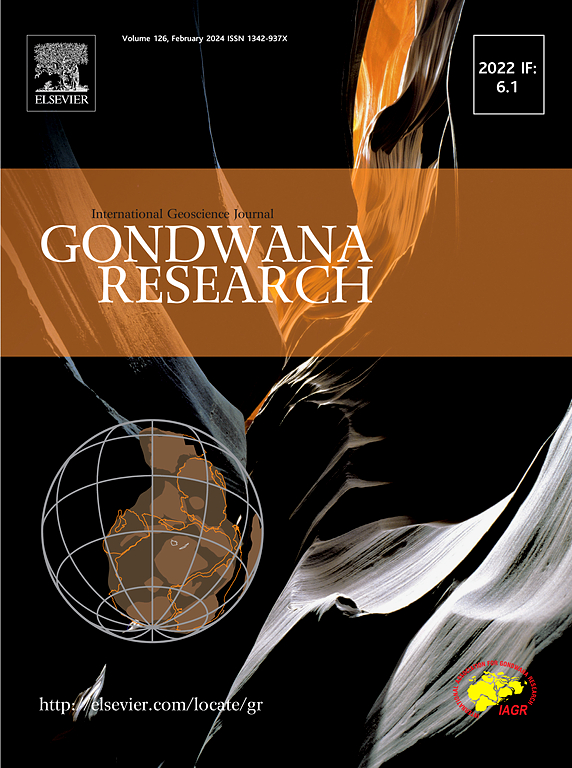The missing arcs of the India-Asia collision
IF 7.2
1区 地球科学
Q1 GEOSCIENCES, MULTIDISCIPLINARY
引用次数: 0
Abstract
Sedimentary provenance studies indicate a Paleocene age for the India-Asia collision, based on the arrival of allochthonous sediment onto the Indian shelf. To account for this age, geodynamic models propose either an extra-large pre-collisional India or an initial collision between India and a Trans-Tethyan Arc situated offshore of Asia. The Burma Terrane is one of the proposed remnants of this arc. However, the existence of this arc has not been thoroughly investigated in regional sedimentary records. We gathered a large dataset (n > 40,000) of detrital zircon ages, including new and previously published data from eastern India, the Burma Terrane, and the Asian margin to identify age populations that could indicate the presence of this arc. Our synthesis suggests that the arrival of allochthonous material onto India is best explained by input from the Asian forearc (specifically, the Xigaze Forearc) alone, without requiring input from an additional missing arc. These constraints are compatible with Trans-Tethyan models only if they incorporate the Xigaze Forearc into the Trans-Tethyan Arc. Additionally, we show that the Burmese sedimentary record necessitates a missing Cretaceous-Paleogene arc located between Myanmar and Asia. Including the Burma Terrane and its missing arc in the Trans-Tethyan Arc is consistent with provenance and paleomagnetic data but implies a complex assembly history for the arc. Ultimately, a Trans-Tethyan Arc is not required to explain the history of the Burma Terrane and its detrital zircon record. Kinematic models involving an extra-large India and a Burma Terrane located offshore of Asia during the Paleogene are also compatible with these constraints.

印度-亚洲碰撞的消失弧线
沉积物源研究表明,印度-亚洲碰撞的年代为古新世,这是基于外来沉积物到达印度陆架的结果。为了解释这个时代,地球动力学模型提出要么是一个超大的碰撞前印度,要么是印度与位于亚洲近海的跨特提斯弧之间的初始碰撞。缅甸地面是这个弧形的遗迹之一。然而,在区域沉积记录中尚未对该弧的存在进行彻底的研究。我们收集了一个大型的碎屑锆石年龄数据集(网址 >; 40,000),包括来自印度东部、缅甸地体和亚洲边缘的新的和以前发表的数据,以确定可能表明该弧存在的年龄群体。我们的综合表明,外来物质到达印度最好的解释是来自亚洲前弧(特别是日喀则前弧)的输入,而不需要来自额外缺失的弧的输入。这些约束条件只有在日喀则弧与外特提斯弧合并时才能与外特提斯弧兼容。此外,我们认为缅甸的沉积记录需要在缅甸和亚洲之间缺失白垩纪-古近纪弧。将缅甸地体及其缺失的弧纳入外特提斯弧与物源和古地磁资料一致,但暗示了弧的复杂组合历史。最终,跨特提斯弧并不需要用来解释缅甸地体及其碎屑锆石记录的历史。古近纪亚洲近海的超大型印度板块和缅甸板块的运动学模型也符合这些约束条件。
本文章由计算机程序翻译,如有差异,请以英文原文为准。
求助全文
约1分钟内获得全文
求助全文
来源期刊

Gondwana Research
地学-地球科学综合
CiteScore
12.90
自引率
6.60%
发文量
298
审稿时长
65 days
期刊介绍:
Gondwana Research (GR) is an International Journal aimed to promote high quality research publications on all topics related to solid Earth, particularly with reference to the origin and evolution of continents, continental assemblies and their resources. GR is an "all earth science" journal with no restrictions on geological time, terrane or theme and covers a wide spectrum of topics in geosciences such as geology, geomorphology, palaeontology, structure, petrology, geochemistry, stable isotopes, geochronology, economic geology, exploration geology, engineering geology, geophysics, and environmental geology among other themes, and provides an appropriate forum to integrate studies from different disciplines and different terrains. In addition to regular articles and thematic issues, the journal invites high profile state-of-the-art reviews on thrust area topics for its column, ''GR FOCUS''. Focus articles include short biographies and photographs of the authors. Short articles (within ten printed pages) for rapid publication reporting important discoveries or innovative models of global interest will be considered under the category ''GR LETTERS''.
 求助内容:
求助内容: 应助结果提醒方式:
应助结果提醒方式:


